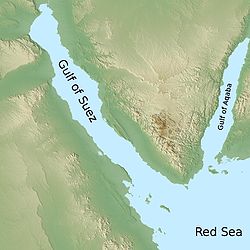Gulf of Aqaba
| The Gulf of Aqaba خليج العقبة (Arabic) מפרץ אילת (Hebrew) |
|
|---|---|
| The Gulf of Eilat | |

The Sinai Peninsula with the Gulf of Aqaba to the east and the Gulf of Suez to the west
|
|
| Location | Southwest Asia and Northeast Africa |
| Coordinates | 28°45′N 34°45′E / 28.750°N 34.750°ECoordinates: 28°45′N 34°45′E / 28.750°N 34.750°E |
| Type | Gulf |
| Primary inflows | Red Sea |
| Basin countries | Egypt, Israel, Jordan, and Saudi Arabia |
| Max. length | 160 km (99 mi) |
| Max. width | 24 km (15 mi) |
| Max. depth | 1,850 m (6,070 ft) |
The Gulf of Aqaba (Arabic: خليج العقبة, Khalij al-Aqabah) or Gulf of Eilat (Hebrew: מפרץ אילת, Mifrats Eilat) is a large gulf at the northern tip of the Red Sea, east of the Sinai Peninsula and west of the Arabian mainland. Its coastline is divided between four countries: Egypt, Israel, Jordan, and Saudi Arabia.
The gulf is east of the Sinai Peninsula and west of the Arabian Peninsula. With the Gulf of Suez to the west, it extends from the northern portion of the Red Sea. It reaches a maximum depth of 1,850 m in its central area: the Gulf of Suez is significantly wider but less than 100 m deep.
The gulf measures 24 kilometres (15 mi) at its widest point and stretches some 160 kilometres (99 mi) north from the Straits of Tiran to where Israel meets Egypt and Jordan.
Like the coastal waters of the Red Sea, the gulf is one of the world's premier sites for diving. The area is especially rich in coral and other marine biodiversity and has accidental shipwrecks and vessels deliberately sunk in an effort to provide a habitat for marine organisms and bolster the local dive tourism industry.
At this northern end of the gulf are three important cities: Taba in Egypt, Eilat in Israel, and Aqaba in Jordan. They are strategically important commercial ports and popular resorts for tourists seeking to enjoy the warm climate. Further south, Haql is the largest Saudi Arabian city on the gulf. On Sinai, Sharm el-Sheikh and Dahab are the major centers.
...
Wikipedia
